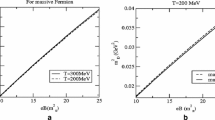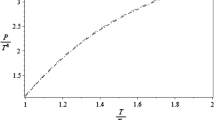Abstract
In QCD, the strengths of the large scale temperature dependent chromomagnetic, B3, B8, and usual magnetic, H fields spontaneously generated in quark-gluon plasma after the deconfinement phase transition (DPT), are estimated. The consistent at high temperature effective potential accounting for the oneloop plus daisy diagrams is used. The heavy ion collisions at the LHC and temperatures T not much higher than the phase transition temperature Td are considered. The critical temperature for the magnetized plasma is found to be Td (H) ∼ 110–120 MeV. This is essentially lower compared to the zero field value Td (H=0) ∼ 160–180 MeV usually discussed in the literature. Due to contribution of quarks, the color magnetic fields act as the sources generating H. The strengths of the fields are B3(T), B8(T) ∼ 1018–1019 G, H(T) ∼ 1016–1017 G for temperatures T ∼ 160–220 MeV. At temperatures T < 110–120 MeV the effective potential minimum value being negative approaches to zero. This is signaling the absence of the background fields and color confinement.
Similar content being viewed by others
References
H. Satz, “The fireball paradigm,” Lect. Notes Phys. 841, 1 (2012).
J. Greensite, “An introduction to the confinement problem,” Lect. Notes Phys. 821 (2011).
O. K. Kalashnikov, “QCD at finite temperature,” Fortsch. Phys. 32, 525 (1984).
G. S. Bali et al., “The QCD transition in external magnetic fields,” PoS(ConfinementX), 197 (2012).
L. Levkova and C. DeTar, “Quark-gluon plasma in an external magnetic field,” Phys. Rev. Lett. 112, 012002 (2014).
K. Szabo, “QCD at non-zero temperature and external magnetic fields,” PoS(LATTICE2013), 014 (2014).
G. S. Bali, F. Bruckmann, G. Endrodi, and A. Schäfer, “Magnetization and pressures at nonzero magnetic fields in QCD,” PoS(LATTICE2013), 182 (2014).
D. Grasso and H. R. Rubinstein, “Magnetic fields in the early universe,” Phys. Rep. 348, 163–266 (2001).
E. Elizalde and V. Skalozub, “Spontaneous magnetization of the vacuum and the strength of the magnetic field in the hot universe,” Eur. Phys. J. C 72, 1968 (2012).
V. V. Skalozub and A. V. Strelchenko, “On the generation of abelian magnetic fields in SU(3) gluodynamics at high temperature,” Eur. Phys. J. C 33, 105 (2004).
V. Skalozub, “Effective coupling constants in gauge theories at high temperature,” Int. J. Mod. Phys. A 11, 5643 (1996).
V. Skalozub and M. Bordag, “Colour ferromagnetic vacuum state at finite temperature,” Nucl. Phys. B 576, 430 (2000).
M. D. Pollock, “Magnetic fields and vacuum polarization at the Planck era,” Int. J. Mod. Phys. D 12, 1289 (2003).
V. I. Demchik and V. V. Skalozub, “The spontaneous generation of magnetic fields at high temperature in a supersymmetric theory,” Eur. Phys. J. C 27, 601–607 (2003).
J. I. Kapusta, Finite-Temperature Field Theory (Cambridge Univ. Press, Cambridge, 1989).
V. Demchik and V. Skalozub, “The spontaneous creation of a chromomagnetic field and A0-condensate at high temperature on a lattice,” J. Phys. A 41, 16405 (2008).
A. I. Akhiezer and V. B. Berestetski, Quantum Electrodynamics (Nauka, Moscow, 1969; Wiley, New York, 1965).
S. Antropov, M. Bordag, V. Demchik and V. Skalozub, “Long range chromomagnetic fields at high temperature,” Int. J. Mod. Phys. A 26, 4831–4843 (2011).
H. E. Haber and H. A. Weldon, “On the relativistic Bose-Einstein integrals,” J. Math. Phys. 23, 1852 (1982).
V. Demchik and V. Skalozub, “Spontaneous magnetization of a vacuum in the hot universe and intergalactic magnetic fields,” Phys. Part. Nucl. 46, 1–23 (2015).
V. Skalozub and P. Minaiev, “On magnetization of quark-gluon plasma at the LHC experiment energies,” Visn. Dniprop. Univ., Fiz., Radioelektron. 24, 25 (2016); arXiv:1612.00216 [hep-ph].
A. O. Starinets, A. S. Vshivtsev, and V. Ch. Zhukovsky, “Colour ferromagnetic state in SU(2) gauge theory at finite temperature,” Phys. Lett. B 322, 40 (1994).
N. O. Agasian and S. M. Fedorov, “Quark-hadron phase transition in a magnetic field,” Phys. Lett. B 663, 445 (2008).
P. Cea, L. Cosmai, and M. D’Elia, “The QCD phase diagram for external magnetic fields,” J. High Energy Phys. 0712, 097 (2007).
G. S. Bali et al., “The QCD phase diagram for external magnetic fields,” J. High Energy Phys. 1202, 044 (2012).
B. V. Galilo and S. N. Nedelko, “Impact of strong electromagnetic field on the QCD effective potential for homogeneous abelian gluon field configurations,” Phys. Rev. D: Part. Fields 84, 094017 (2011).
S. Ozaki, “QCD effective potential with strong U(l)lem magnetic fields,” Phys. Rev. D: Part. Fields 89, 054022 (2014).
V. D. Orlovsky and Yu. A. Simonov, “The quark-hadron thermodynamics in magnetic field,” Phys. Rev. D: Part. Fields 89, 054012 (2014).
C. Bonati, M. D’Elia, M. Mariti, M. Mesiti, F. Negro, A. Rucci, and F. Sanfilippo, “Magnetic field effects on the static quark potential at zero and finite temperature,” Phys. Rev. D: Part. Fields 94, 094007 (2016).
M. D’Elia, E. Meggiolaro, M. Mesiti, and F. Negro, “Gauge-invariant field-strength correlators for QCD in a magnetic background,” Phys. Rev. D: Part. Fields 93, 054017 (2016).
C. Bonati, M. D’Elia, M. Mariti, M. Mesiti, F. Negro, and F. Sanfilippo, “Anisotropy of the quark-antiquark potential in a magnetic field,” Phys. Rev. D: Part. Fields 89, 114502 (2014).
Author information
Authors and Affiliations
Corresponding author
Additional information
The article is published in the original.
Rights and permissions
About this article
Cite this article
Skalozub, V., Minaiev, P. Magnetized Quark-Gluon Plasma at the LHC. Phys. Part. Nuclei Lett. 15, 568–575 (2018). https://doi.org/10.1134/S1547477118060171
Received:
Published:
Issue Date:
DOI: https://doi.org/10.1134/S1547477118060171




